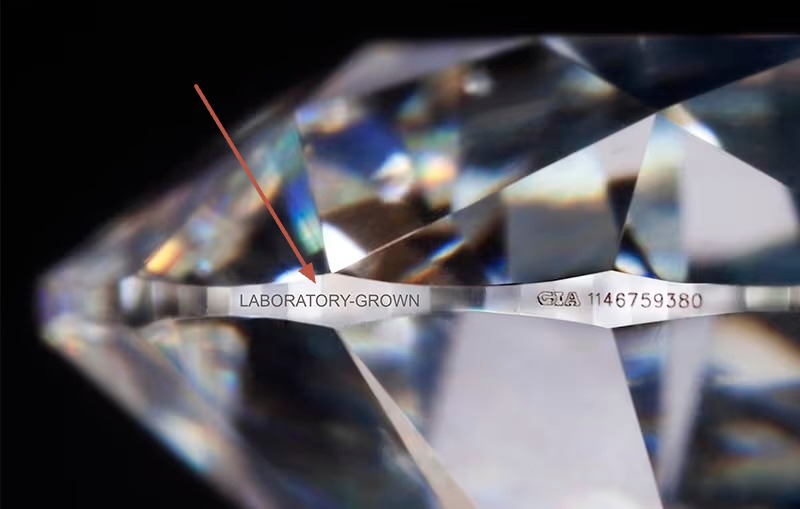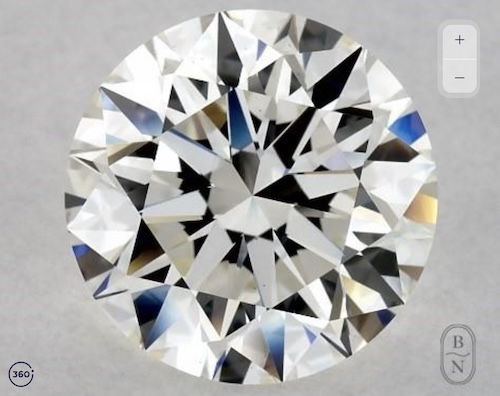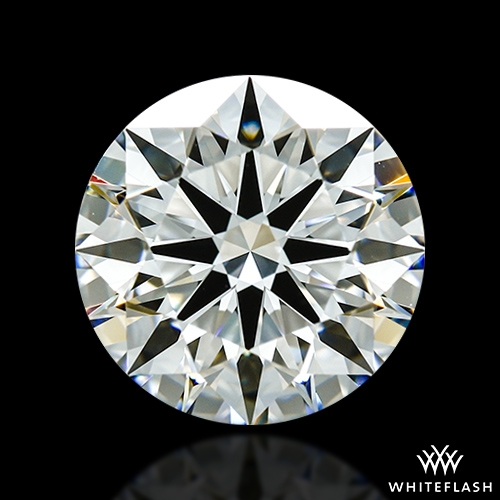The choice between natural and lab-created diamonds has become a central topic in the world of fine jewelry. Both types hold their unique allure and significance, appealing to different preferences and values. While this piece aims to provide a balanced view, it’s worth noting that the tide is increasingly turning towards lab diamonds, not just for their environmental and ethical benefits but also for their quality and value. In this exploration of natural versus lab diamonds, we delve into what each type offers, starting with an understanding of what lab-created diamonds are and how they compare to their natural counterparts.
What's In This Guide
ToggleWhat is a Lab-Created Diamond?
Lab-created diamonds, also known as synthetic or cultured diamonds, are genuine diamonds produced in controlled laboratory environments. The process of creating these diamonds replicates the natural conditions under which diamonds form over millions of years. Two primary methods are used for this creation:
- Chemical Vapor Deposition (CVD): In the CVD process, a small diamond seed is placed in a chamber filled with carbon-rich gases. The chamber is heated to high temperatures, causing the gases to break down and carbon atoms to accumulate on the diamond seed, gradually forming a larger diamond.
- High Pressure, High Temperature (HPHT): The HPHT method mimics the natural process of diamond formation. It involves placing a diamond seed in a press with carbon and subjecting it to high temperatures and pressures, resulting in the growth of the diamond.
Both methods produce diamonds that are chemically, physically, and optically identical to natural diamonds. The primary difference lies in their origin – lab diamonds are created in weeks or months, while natural diamonds take millions of years to form in the Earth’s mantle.
For a more detailed explanation of these processes and their differences, you can visit this page on HPHT vs CVD. Understanding these methods is crucial in appreciating the technological marvel behind lab-created diamonds and recognizing their legitimacy and value in the jewelry industry.
Looking for the best lab diamonds? I recommend Whiteflash for the best quality, James Allen have a great selection and also Brilliant Earth are worth considering.
Lab Diamonds vs. Natural Diamonds – What are the Differences
When comparing lab diamonds to natural or “real” diamonds, it’s essential to recognize the similarities and differences between them. Both are “real” in terms of their chemical composition and properties, but they differ in origin, environmental impact, and often in cost.
Origin and Creation Process:
- Natural Diamonds: Formed over billions of years under high-pressure and high-temperature conditions deep within the Earth’s mantle, natural diamonds are then brought to the surface through volcanic eruptions. Their creation is a slow, natural process, making each diamond unique.
- Lab Diamonds: As discussed earlier, lab diamonds are created using advanced technological processes that mimic natural diamond formation conditions – either through HPHT or CVD. These processes are much faster, taking only a few weeks to months.
Environmental and Ethical Impact:
- Natural Diamonds: The mining of natural diamonds has often been associated with significant environmental disruption, including soil erosion, deforestation, and ecosystem destruction. There are also ethical concerns, including labor practices in certain diamond-mining areas.
- Lab Diamonds: Lab-created diamonds offer a more environmentally friendly and ethical alternative. The production process has a smaller carbon footprint and eliminates the socio-political issues often associated with diamond mining.
Cost and Value:
- Natural Diamonds: Generally, natural diamonds tend to be more expensive due to the extensive mining process and the perceived rarity. The price also varies greatly depending on the diamond’s size, quality, and other factors.
- Lab Diamonds: Lab diamonds usually cost less than natural diamonds, often by 20-40%. This lower cost is due to the more efficient production process and the growing availability of lab-grown diamonds.
Quality and Characteristics:
- Both lab and natural diamonds are identical in terms of physical, chemical, and optical properties. They have the same hardness, refractive index, and appearance. The differences in inclusions or flaws that occur in natural diamonds can also be replicated in lab diamonds.
Market Perception and Resale Value:
- The perception of value can differ. Natural diamonds have long been marketed as rare and precious, which can influence their resale value. Lab diamonds, being relatively new in the market, may not hold the same perception, but this is rapidly changing as awareness and acceptance grow.
While lab diamonds and natural diamonds are virtually indistinguishable in terms of quality and appearance, they differ significantly in their origin, environmental and ethical implications, and cost. Understanding these differences is key for consumers to make informed decisions based on their values and preferences. Find the best best lab diamonds at Whiteflash for the best quality, James Allen are a good option because of their large selection and also Brilliant Earth is a great option for colored lab diamonds.
Can You Tell the Difference Between Lab Diamonds and Natural Diamonds?
A common question among consumers considering lab diamonds is whether these stones can be distinguished from natural diamonds with the naked eye. The straightforward answer is no; without specialized equipment, it’s virtually impossible to tell the difference between a lab-grown diamond and a natural diamond based on appearance alone.
- Identical in Appearance: Both lab diamonds and natural diamonds are made of carbon atoms in a crystalline structure. This similarity in composition means they share the same sparkle, brilliance, and overall aesthetic. To the untrained eye, and even to most experts, they appear identical.
- Specialized Equipment for Identification: The only reliable way to differentiate between a lab diamond and a natural diamond is through specialized testing using advanced gemological equipment. These tests can detect minor differences in trace elements and crystal growth patterns that are characteristic of the different formation processes.
- Origin as the Primary Difference: The fundamental difference between lab diamonds and natural diamonds lies in their origin. Natural diamonds are formed over billions of years under the Earth’s crust, while lab diamonds are created in controlled laboratory environments over a much shorter period. This distinction in origin does not affect the visual or structural properties of the diamond but is more about personal preference and values.
- Certification and Disclosure: Reputable jewelers and diamond sellers always disclose the origin of their diamonds. Lab diamonds are typically sold with certification that clearly states their laboratory origin, ensuring transparency for the buyer. In addition, lab diamonds will have the inscription “LG” or “Laboratory Grown”

In essence, the debate between lab diamonds and natural diamonds does not center on visible differences, as there are virtually none. Instead, it revolves around considerations like environmental impact, ethical sourcing, and cost-effectiveness. For those who prioritize sustainability and affordability, lab diamonds present a compelling alternative, offering the beauty and quality of traditional diamonds without the associated environmental and ethical concerns.
My Opinion on Lab Diamonds: Quality Matters
I have a profound appreciation for lab diamonds, primarily for their ethical production, environmental sustainability, and affordability. However, it’s crucial to emphasize that not all lab diamonds are created equal. The key to a satisfying purchase is focusing on getting the best quality, particularly in terms of the cut.
- Importance of Cut Quality: The cut quality of a lab diamond significantly influences its brilliance and fire. A well-cut diamond will exhibit superior sparkle and visual appeal. Therefore, when selecting a lab diamond, priority should be given to the precision of the cut.
- Variability in Quality: Just like their natural counterparts, lab diamonds can vary in quality. It’s essential to be discerning and seek diamonds that meet high standards in terms of cut, color, clarity, and carat.
- Educated Buying Decisions: Buyers should educate themselves about the 4Cs of diamond quality and understand the certification process. Opting for a diamond that is certified by a reputable lab ensures that you are getting a quality product.
- Balancing Factors: While focusing on cut quality, do not overlook other factors like ethical sourcing and sustainability practices, which add to the overall value of the diamond.
In essence, my endorsement of lab diamonds is underpinned by the belief that quality should never be compromised. A well-informed choice focusing on superior cut quality will ensure that the lab diamond you choose is not just beautiful and ethical, but also a symbol of lasting value.

An example of a diamond which isn’t well cut
Where to Buy Lab Diamonds: Top Recommendations
When it comes to purchasing lab diamonds, here are my top recommendations based on quality, selection, and service:
- Whiteflash – Precision Lab: Whiteflash stands out with its Precision Lab Diamonds, which features lab diamonds with exceptional cut quality. These diamonds come with light performance images and HD videos, offering assurance of their superior quality. The Precision Lab Collection is ideal for those seeking the best quality lab diamonds available in the market.
- Brilliant Earth – Diverse and Colorful Options: Brilliant Earth offers a wide range of lab diamonds, including some stunning colored options. Their focus on sustainability and ethical sourcing, coupled with a diverse selection, makes them a great choice for a variety of preferences.
- James Allen – Extensive Selection: James Allen is known for its large selection of lab diamonds, offering a range of choices in terms of size, cut, and price. Their user-friendly website and customization options make the buying process straightforward and enjoyable.
- Blue Nile – Great Selection with Financing Options: Blue Nile also offers a vast selection of lab diamonds, catering to different tastes and budgets. They are particularly notable for their financing options, making high-quality lab diamonds more accessible to a broader range of customers.
Embracing the Future with Lab Diamonds
In conclusion, lab diamonds represent a significant and positive shift in the jewelry industry, merging technological advancement with ethical and environmental consciousness. My personal inclination towards lab diamonds is rooted in their sustainable production and the incredible value they offer. However, it’s crucial to remember that quality should always be the priority. The brilliance and beauty of a diamond, lab-created or natural, largely depend on its cut and overall quality.
When selecting a lab diamond, it’s essential to choose a reputable retailer that aligns with your preferences for quality, variety, and ethical practices. Whether you opt for the unparalleled cut quality of Whiteflash’s Precision Lab Collection, the diverse and colorful options at Brilliant Earth, the extensive selection of James Allen, or the accessible luxury offered by Blue Nile, you’re making a choice that’s not just aesthetically pleasing but also environmentally and socially responsible.
Lab diamonds are not just a trend; they are a testament to how luxury and responsibility can coexist harmoniously. By choosing lab diamonds, you’re not only investing in a piece of timeless beauty but also contributing to a more sustainable and ethical future in the world of fine jewelry.

